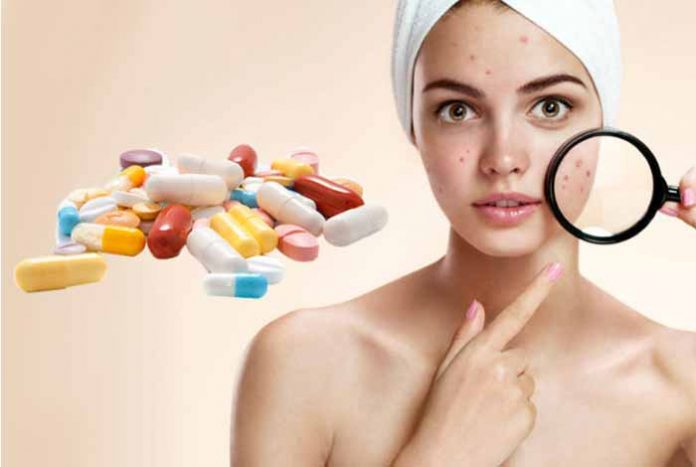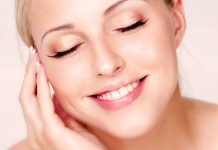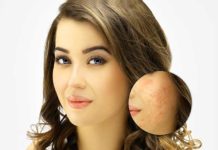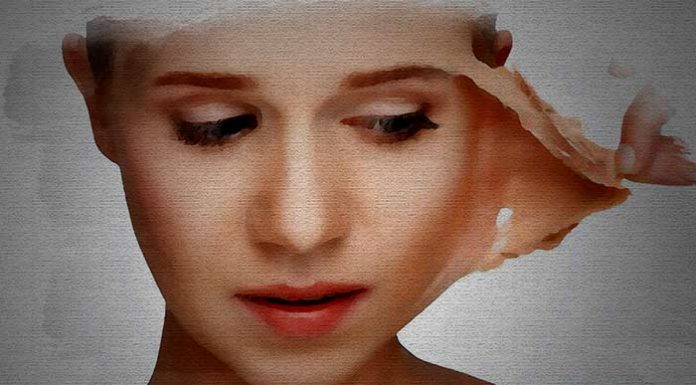
Waking up with a zit on the skin can be terrifying. These zits are nothing but acne and affect almost 85% of young adults.
Acne (medically known as Acne vulgaris) is a chronic inflammatory condition of the skin caused by the obstruction of hair follicle with sebum and dead skin cells. The sebaceous glands of our skin produce sebum or oil, which has a protective action. Whenever there is excess production of sebum it along with dead skin cells forms a plug which can occlude your hair follicle. When the plug gets contaminated by the skin bacteria, it produces pustules, papules or cysts.
Mild acne can be easily managed through natural remedies. However, severe acne necessitates the use of medications.
Symptoms
Acne may have a varied presentation, depending on the severity of your condition. These are described below.
- Blackheads (Open comedones) occur when the clogged pore is open to the skin surface.
- Whiteheads (Closed comedones) have a closed clogged pore
- Papules or small red tender bumps, occur when the wall of the clogged pore breaks down due to inflammation.
- Pustules or pimples arise when the papule gets filled with pus.
- Solid, painful, large lumps underneath the skin are known as nodules and originate as a result of constant irritation to the papule.
- Largest from of acne, i.e. cyst occurs due to severely infected clogged pore.
Treatment
Different procedures for treatment of acne are directed towards tackling the underlying mechanism involved in the formation of acne. Different processes like increased keratinization of follicles, increased sebum production, inflammation and colonization by skin bacteria (i.e. Propionibacterium acne) are all involved in the production of acne and most of the current treatments for acne are focused on limiting one more of these processes.
Although acne can be treated through various home remedies and over-the counter products, severe acne or scarring caused by acne necessitates a dermatologist’s consultation.
Most of the medications that are used to effectively manage acne are topical preparations, such as creams, lotions, gels, washes, etc. Anti-acne drugs available as topical preparations include benzoyl peroxide, keratolytics, adapalene, azelaic acid, topical retinoids and topical antibiotics.
Some oral drugs are also advocated in the treatment of acne, including oral retinoids, oral contraceptives, spironolactone and certain antibiotics such as tetracycline, minocycline and doxycycline.
However, in some cases, medications may not effectively treat the persisting scar of acne. Recent treatment advances can play a vital role in these individuals. Anti-scar procedures such as dermabrasion, lasers and chemical peeling, aid in restoring a healthy skin.
The most commonly used drugs in acne are described below.
1. Benzoyl Peroxide
It is one of the most effective and most widely used drug in acne. It releases free-radical oxygen which destroys bacteria, in particular anaerobic and microaerophilic bacteria.
Although the primary acting mechanism of benzoyl peroxide is its bactericidal action, it also has mild keratolytic and comedolytic properties i.e. it produces mild desquamation, causes shedding of comedone caps and reduces the production of fatty acids in sebum which may act as irritants.
Available as: Topical preparations only, in the form of lotions, gels, creams and washes.
US-FDA Status: Approved for Acne
Availability: Prescription/ OTC
Generic name: benzoyl peroxide
Brand name: Brevoxyl gel
Side-effects: Skin rash, skin irritation, breathing difficulty, hives, tightness in throat
Indicated in pregnancy: Only if benefit outweighs risk to fetus
Alcohol content: Present
2. Keratolytics
Skin is made up of several layers of cells with an intercellular substance interspersed in between the cells. The chief action of a keratolytic drug is dissolution of the intercellular substance in the outermost layer of skin, i.e. horny layer (histologically called as stratum corneum). By doing so, it causes thinning of skin on and around the lesion. Therefore, it is mainly used in the treatment of hyperkeratotic skin lesions, such as corns, warts, psoriasis, ringworm, athletes foot, etc.
However, the desquamation of skin caused by application of keratolytic, also aids in the treatment of acne.
I. Salicylic acid
Unlike other anti-acne medications, salicylic acid does not alter the sebum production or kill bacteria. It unclogs the skin pores and aids in resolution of the acne. It also prevents the recurrence of acne in future. However, it has to be used continuously to produce and retain the desirable results.
Available as: Topical preparations
US-FDA Status: Approved for Acne
Availability: Prescription/ OTC
Generic name: salicylic acid
Brand name: Duofilm gel
Side-effects: Skin irritation, dryness of skin, hives or itching, skin redness
Indicated in pregnancy: Only if benefit outweighs risk to fetus
Alcohol content: Present
II. Sulfur
It acts as a keratolytic and antiseptic agent. It usually produces a mild effect. It also has anti-fungal effect and is hence, primarily indicated in the treatment of dandruff.
Available as: Topical preparations
US-FDA Status: Approved for Acne
Availability: Prescription/ OTC
Generic name: sulfur
Brand name: Acnotex
Side-effects: Skin irritation or redness, peeling, dryness or burning of skin
Indicated in pregnancy: Only if benefit outweighs risk to fetus
Alcohol content: Contains traces of alcohol
III. Resorcinol
It has antiseptic, anti-fungal and keratolytic property. It causes desquamation by breaking down the hardened, rough and scaly skin. It also disinfects the skin and act against infections.
Other than acne, it also aids in the treatment of various skin lesions, such as eczema, dandruff, psoriasis, etc.
Available as: Topical preparations
US-FDA Status: Approved for Acne
Availability: Prescription/ OTC
Generic name: resorcinol
Brand name: Resinol
Side-effects: Skin irritation or redness, peeling, dryness or burning of skin
Indicated in pregnancy: Only if benefit outweighs risk to fetus
Alcohol content: Absent
3. Retinoids
These are Vitamin A derivatives. Retinoids have comedolytic and keratolytic property. This group of drugs rectifies the abnormal keratinization of follicles and prevents the formation of comedones. These are usually initiated as a first-line therapy and also, as a maintenance therapy to prevent the formation of microcomedones later. All retinoids, except tretinoin, can be used in combination with other drugs, such as benzoyl peroxide. Retinoids are also effective against other skin ailments such as warts, psoriasis and have anti-aging effects.
Available as: Topical and Oral preparations
Topical Retinoids
US-FDA Status: Approved for Acne
Availability: Prescription Only
Generic name: tretinoin
Brand name: Retin-A gel
Side-effects: Peeling of skin, burning of skin, unusual dryness of skin, skin redness
Indicated in pregnancy: Usually Contraindicated
Alcohol content: Contains 90% w/w alcohol
Caution: Never use this drug along with benzoyl peroxide as benzoyl peroxide stimulates the degradation of tretinoin, hence making it less effective. However, alternate use of tretinoin and benzoyl peroxide is harmless (i.e. use one in morning and other at night).
Oral Retinoids
US-FDA Status: Approved for Acne
Availability: Prescription Only
Generic name: isotretinoin
Brand name: Amnesteem
Side-effects: Nose bleeds, redness and itching of eyes, joint or bone pain, skin rash
Indicated in pregnancy: Usually Contraindicated
Alcohol content: Absent
4. Adapalene
It is a retinoid-like drug which has anti-inflammatory property. It binds to retinoic acid receptors and prevents the formation of comedones. It is as effective as tretinoin and causes less irritation.
Available as: Topical preparations only
US-FDA Status: Approved for Acne
Availability: Prescription/ OTC
Generic name: adapalene
Brand name: Differin gel
Side-effects: Itching of skin, dryness of skin, peeling of skin
Indicated in pregnancy: Usually Contraindicated
Alcohol content: Absent
5. Antibiotics
Antibiotics are useful in treatment of acne because of their potential to act against the skin bacteria, called Propionibacterium acnes (P.acnes). Antibiotics produce an anti-inflammatory effect but are non-comedolytic. Hence, oral antibiotics in particular are considered as a mainstay in moderate to severe inflammatory acne vulgaris. However, a major complication associated with consumption of antibiotics is emergence of resistance. To combat this, a concomitant use of topical retinoids or benzoyl peroxide is recommended.
Various classes of antibiotics that are used in the treatment of acne are as follow:.
I. Lincosamide Antibiotics
This group of drug has a bacteriostatic action. It acts by inhibiting the microbial protein synthesis, thus acting against the acne-causing bacteria.
A. Clindamycin
Available as: Topical preparations
Clindamycin alone
US-FDA Status: Approved for Acne
Availability: Prescription Only
Generic name: clindamycin phosphate
Brand name: Clindagel
Side-effects: Fever, nausea, vomiting, abdominal cramps, increased thirst, weakness, unusual tiredness
Indicated in pregnancy: Usually safe during pregnancy
Alcohol content: Absent
Combination of Clindamycin and Topical Retinoid
US-FDA Status: Approved for Acne
Availability: Prescription Only
Generic name: clindamycin phosphate/ tretinoin (topical)
Brand name: Veltin gel
Side-effects: Peeling and dryness of skin, itching, unusually warm skin, redness of skin
Indicated in pregnancy: Usually Contraindicated, especially during first trimester
Alcohol content: Absent
II. Macrolides
Macrolides are bacteriostatic agents. This group of drug inhibits bacterial protein synthesis by binding to a specifc ribosomal subunit, called 50S. Thus, it inhibits the growth of acne-causing bacteria.
A. Erythromycin
Available as: Topical preparations
Erythromycin alone
US-FDA Status: Approved for Acne
Availability: Prescription Only
Generic name: erythromycin
Brand name: Erythromycin gel
Side-effects: Peeking of skin, dry red skin, itching
Indicated in pregnancy: Only when benefit outweighs fetal risks
Alcohol content: Each gram of 2% gel contains around 92% alcohol
Combination of Erythromycin and Benzoyl Peroxide
US-FDA Status: Approved for Acne
Availability: Prescription Only
Generic name: benzoyl peroxide (5%) / erythromycin (3%)
Brand name: Benzamycin gel
Side-effects: Bristling, crusting, redness and swelling of skin, painful skin irritation, swelling of eyes, nose, face
Indicated in pregnancy: Only when benefit outweighs fetal risks
Alcohol content: Each gram of gel contains 20% alcohol
Earlier, oral erythromycin was used to treat acne. However, later it was discontinued due to emergence of resistant strains of P. acnes.
III. Tetracycline Group of Antibiotics
It is a class of antibiotics with a broad-spectrum activity. It usually is the first choice of antibiotic for treating acne. It inhibits protein synthesis of the bacteria and thus, is useful in severe acne.
A. Tetracycline
Available as: Oral preparations
US-FDA Status: Approved for Acne
Availability: Prescription/ OTC
Generic name: tetracycline hydrochloride
Brand name: Achromycin V capsule
Side-effects: Increased skin sensitivity to sunlight, appetite loss, abdominal pain, nausea, vomiting
Indicated in pregnancy: Usually contraindicated
Alcohol content: Absent
B. Minocycline
Available as: Oral preparations
US-FDA Status: Approved for Acne
Availability: Prescription Only
Generic name: minocycline hydrochloride
Brand name: Dynacin capsule
Side-effects: Black tarry stools, double vision, blood in urine or stools, confusion, chest pain, diarrhea
Indicated in pregnancy: Usually contraindicated
Alcohol content: Absent
C. Doxycycline
Available as: Oral preparations
US-FDA Status: Approved for Acne
Availability: Prescription Only
Generic name: doxycycline hyclate
Brand name: Acticlate capsule
Side-effects: Chills, constipation, cough, bloating, clay colored stools, dark urine, diarrhea
Indicated in pregnancy: Only when benefit outweighs fetal risks
Alcohol content: Absent
IV. Sulfone Antibiotics
This group of drugs inhibits an enzyme, called myeloperoxidase, which has a key role in inflammation. Hence, it is a potent anti-inflammatory and immuno-modulatory drug. However, this group of drugs is less commonly used in the treatment of acne.
A. Dapsone
Available as: Topical preparations
US-FDA Status: Approved for Acne
Availability: Prescription Only
Generic name: dapsone
Brand name: Aczone gel
Side-effects: Dark urine, bluish colored lips, palms or fingernails, fever, difficulty breathing, dizziness
Indicated in pregnancy: Only when benefit outweighs fetal risks
Alcohol content: Absent
6. Azelaic Acid
It is a natural acid derived from a fungus called Pityrosporum ovale. It inhibits aerobic and anaerobic organisms present on acne-bearing skin. It also lowers the fatty acid content of skin and has a keratolytic effect.
It is also used in another skin condition, known as rosacea.
Available as: Topical preparations
US-FDA Status: Approved for Acne
Availability: Prescription Only
Generic name: azelaic acid
Brand name: Azelex cream
Side-effects: Dryness, itching, peeling or redness of skin, crusting, scaling of skin
Indicated in pregnancy: Only when benefit outweighs fetal risks
Alcohol content: Contains traces of alcohol
7. Oral Contraceptives
Acne are caused when there is excess of androgens or male sex hormones like testosterone in women. These hormones are normally presnt in very low quantities in women. Testosterone stimulates sebum production; hence excess testosterone can cause acne. Thus, use of combined oral contraceptives (a combination of estrogen and progestin) can be beneficial in women with severe acne which is unresponsive to other treatments.
However, contraceptives increase the risk of developing blood clots. Hence, FDA has approved only certain combined oral contraceptive preparations. These are as follows.
A. Ortho Tri-cyclen
Available as: Oral preparations
US-FDA Status: Approved for Acne
Availability: Prescription Only
Generic name: ethinyl estradiol/ norgestimate
Brand name: Estarylla tablet
Side-effects: Visual changes, changes in skin color, abdominal pain, absent, missed or irregular periods, chills, chest pain
Indicated in pregnancy: Absolutely contraindicated
Alcohol content: Absent
B. Estrostep Fe
Available as: Oral preparations
US-FDA Status: Approved for Acne
Availability: Prescription Only
Generic name: ethinyl estradiol/ northindrone
Brand name: Lo Minastrin Fe tablet
Side-effects: Dizzy, breast tenderness, abdominal swelling, vomiting
Indicated in pregnancy: Absolutely contraindicated
Alcohol content: Absent
C. Yaz
Available as: Oral preparations
US-FDA Status: Approved for Acne
Availability: Prescription Only
Generic name: ethinyl estradiol/ drospirenone
Brand name: Loryna tablet
Side-effects: Breast tenderness, severe throbbing headache, irregular menstrual periods, nausea
Indicated in pregnancy: Absolutely contraindicated
Alcohol content: Absent
8. Spironolactone
It belongs to a group of drugs, called Potassium-sparing diuretics. It acts as an anti-androgen agent. Androgens refer to male sex hormones which are natural or synthetic steroid hormones produced by testes and adrenal glands. But, androgens are also produced by ovaries. An increase in the concentration of androgens in females, may sensitize the sebaceous glands, thus leading to excessive sebum production, eventually causing acne.
Spironolactone inhibits the androgen from affecting the sebaceous glands and is hence used in the treatment of acne.
Available as: Oral preparations
US-FDA Status: Approved for Acne
Availability: Prescription Only
Generic name: spironolactone
Brand name: Aldactone tablet
Side-effects: Black tarry stools, chest pain, bleeding gums, abdominal pain, chills
Indicated in pregnancy: Only if benefit outweighs risk to fetus
Alcohol content: Absent
OTC
Most acne resolve with the readily available over the counter medications. However, the availability of these drugs vary among countries, due to the differing norms of the pharmaceutical regulatory bodies of the countries.
Various anti-acne OTC drugs in several countries have been listed below.
| Name of the Country | OTC Drug(s) Available |
| Argentina | Benzoyl peroxide (topical) |
| Australia | Benzoyl peroxide (topical) Azelaic acid (topical) |
| Austria | Benzoyl peroxide (topical) |
| Canada | Benzoyl peroxide (topical) Resorcinol (topical) Salicylic acid (topical) |
| China | Benzoyl peroxide (topical) Tretinoin (topical) Clindamycin (topical) Erythromycin (topical) |
| Czech Republic | Benzoyl peroxide (topical) Azelaic acid (topical) |
| Denmark | Benzoyl peroxide (topical) Resorcinol (topical) |
| France | Benzoyl peroxide (topical) |
| Germany | Benzoyl peroxide (topical) |
| Greece | Benzoyl peroxide (topical) |
| India | Resorcinol (topical) |
| Ireland | Benzoyl peroxide (topical) |
| Italy | Benzoyl peroxide (topical) Azelaic acid (topical) |
| Japan | Tetracycline (topical) Resorcinol (topical) Salicylic acid (topical) |
| Mexico | Benzoyl peroxide (topical) Erythromycin (topical) |
| Philippines | Benzoyl peroxide (topical) Tretinoin (topical) |
| Singapore | Benzoyl peroxide (topical) |
| South Korea | Benzoyl peroxide (topical) Tretinoin (topical) Erythromycin (topical) Tetracycline (topical) |
| Spain | Benzoyl peroxide (topical) |
| Switzerland | Benzoyl peroxide (topical) |
| The Netherlands | Benzoyl peroxide (topical) |
| UK | Benzoyl peroxide (topical) |
| USA | Benzoyl peroxide (topical) Adapalene (topical) Tetracycline (topical) Resorcinol (topical) Sulfur (topical) Salicylic acid (topical) |










